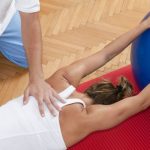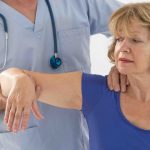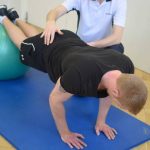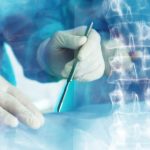We all know that spinal problems can significantly limit the quality of life. One of such problems is a herniated intervertebral disc. While developing, the soft tissue inside the disc can protrude beyond its borders/margins, pressing on nerves, causing pain, and limiting movement. Treatment for a spinal hernia can be conservative or surgical. Surgery is considered only in cases where conservative methods have not brought the desired effect. While surgery can significantly alleviate symptoms, rehabilitation after spinal hernia removal is also an essential step in restoring health.
Goals and Objectives of Rehabilitation after Surgery
The main goal of rehabilitation after spinal hernia removal is to ensure the recovery of spinal functions and prevent the recurrence of hernia. During the operation, the surgeon removes the protruding part of the intervertebral disc, which leads to the reduced pressure on the nerves and spinal tissues. However, after the surgery, any patient may experience pain and discomfort, so rehabilitation is aimed at relieving pain syndrome, improving blood circulation, and restoring muscle tone.
One of the rehabilitation goals is maintaining the patient’s optimal physical condition. This requires regular exercises and gymnastics. Special attention is paid to the muscles that control movement of the spine. Strengthening the muscles contributes to the stabilization of the spine and reduces the probability of hernia recurrence.
Video: “Rehabilitation after spinal hernia removal. Lumber Spine.”
Lumber Spine: Set No1 General rehabilitation and support. Initial stage.
For additional information about the rehabilitation after spinal hernia removal you can watch a video demonstrating exercises and rehabilitation recommendations.
Exercises after Removal of Intervertebral Hernia
After the removal of an intervertebral hernia, patients are usually recommended to perform exercises aimed at improving spinal mobility, strengthening muscles, and reducing the pain syndrome. Here are some exercises that may be included in the rehabilitation program:
- Circular head movement. This exercise allows you to stretch the neck and back muscles, reduce tension in the shoulder area, and improve blood circulation. Start slowly, moving your head clockwise, then counter-clockwise. Repeat the exercise 10 times in each direction.
- Neck muscle stretching. This exercise helps reduce tension in the neck and shoulder muscles, as well as improves blood circulation. First, tilt your head to the right and hold this position for 15-30 seconds, then repeat to the left. Repeat the exercise 3-5 times in each direction.
- Chest muscle stretching. This exercise helps improve the posture and expand the chest. Stand straight, clasp your hands behind your back, raise them as high as possible, pulling your shoulders back. Hold this position for 15-30 seconds, repeat the exercise 3-5 times.
- Thigh muscle stretching. This exercise is aimed at stretching the thigh and buttock muscles, reducing the pain syndrome, and improving mobility. Lie on your back, bend your right knee and put it on the floor, then raise your left leg and hold it with your hands at the knee. Pull your knee towards your chest, hold this position for 15-30 seconds, then repeat on the other side. Repeat the exercise 3-5 times for each leg.
Gymnastics and Physical Therapy after Surgery
Gymnastics and physical therapy (PT) are an important part of rehabilitation after spinal hernia removal. They help strengthen muscles, increase spinal flexibility, reduce the pain syndrome, and improve overall health condition.

PT may include various exercises, depending on the individual needs of the patient and the degree of his physical training. One of the most common types of PT is yoga. Yoga helps improve the posture, strengthen muscles, increase flexibility, and reduce stress. However, it should be noted that some yoga exercises may be too strenuous for patients after spinal hernia surgery. Therefore, before starting PT, it is necessary to get a doctor’s consultation and conduct sessions under the supervision of an experienced instructor.
In addition, gymnastics is also an important part of rehabilitation after spinal hernia removal. It can include various exercises aimed at strengthening muscles, improving mobility, and spinal flexibility. It is recommended to perform gymnastics for 20-30 minutes every day, while avoiding too strenuous exercises and consulting with a doctor.
Corset after Hernia Removal: Role, Duration of Wearing
Corsets are special devices that are worn on the waist to provide additional support to the spine. After spinal hernia removal surgery, a doctor may prescribe a patient to wear a corset. A corset helps reduce the load on the spine, provides additional support, and improves the posture.
However, a corset should only be worn on a doctor’s prescription and only for a certain period. If the corset is worn for too long, the muscles may weaken, which can lead to a deterioration in health condition. Also, wearing a corset can lead to discomfort and discomfort.
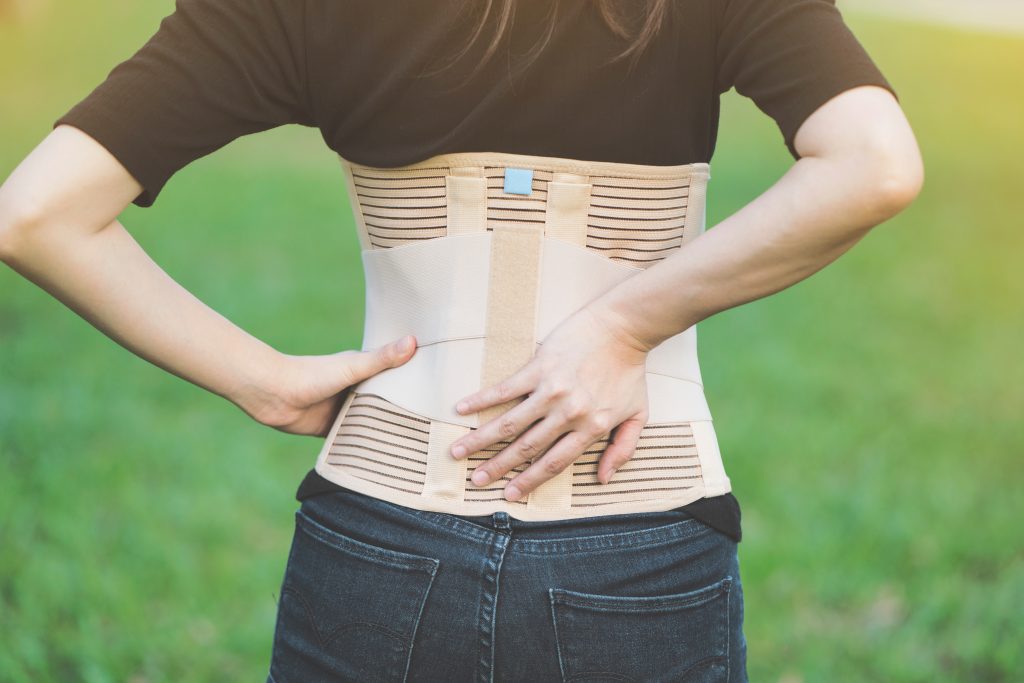
The duration of wearing a corset after the surgery can vary depending on the individual needs of the patient and the degree of his recovery. Typically, a corset is worn for 2-4 weeks after the surgery, but the terms can be extended or reduced depending on the course of rehabilitation.
When can I sit down after the surgery?
After spinal hernia removal surgery, patients are recommended to avoid prolonged sitting for the first few weeks. Prolonged sitting can bring additional strain to the spine and lead to health deterioration. Instead, patients are recommended to walk, lie on their back, or stand, while avoiding staying in the same position for too long.
Gradually, over the time, you can start sitting for short periods, gradually increasing the sitting time. It’s important to remember that prolonged sitting can have a negative impact on the spine’s condition and contribute to the recurrence of the hernia, so this should be avoided.
Leg Pain after the Surgery
Leg pain is one of the most common complications after spinal hernia removal surgery. It can be caused by various factors such as tissue inflammation, nerve irritation, or nerve damage during surgery.
To reduce pain and improve the patient’s condition, a doctor may recommend analgesics or physiotherapeutic procedures. In addition, it’s important to maintain the correct posture throughout the day and avoid staying in the same position for too long, whether sitting or standing.
Hernia Recurrence after the Removal Surgery
Hernia recurrence after the removal surgery is a possible complication. While surgery can significantly reduce the risk of recurrence, there is no 100% guarantee that it will not occur again. Recurrence can be caused by incorrect exercise technique, poor regimen adherence, weak muscle support, and other factors.
If a patient experiences symptoms indicating a possible hernia recurrence, such as pain in the spine, legs, or arms, he should see a doctor. The doctor will conduct the necessary examination and prescribe the necessary treatment depending on the causes of the recurrence.
Stages of Patient Recovery
Recovery after spinal hernia removal surgery is a long and multi-stage process. Each patient has individual needs and requires an individual approach.
The first stage is in-hospital rehabilitation. For several days after the surgery, patients may stay in the hospital under a constant medical supervision. During this period, patients may be prescribed analgesics, physiotherapy procedures, and other treatment methods aimed at improving health condition.
The second stage is the period after discharge from the hospital. During this period, patients are recommended to follow a regimen, perform exercises, and monitor their health condition. It’s important to avoid physical activity, and it’s not recommended to sit or stand in one position for a long time. During this period, patients can attend physiotherapy sessions to strengthen muscles and improve spine mobility.
The third stage is the period of long-term recovery. During this period, patients are recommended to continue doing exercises, maintain the correct posture, and avoid intensive physical activity. Patients can attend physiotherapy sessions, yoga, or other types of physical therapy to strengthen muscles and maintain a healthy spine condition.
What Should Be Immediately Reported to a Doctor After the Surgery?
After spinal hernia removal surgery, patients should pay attention to their health and immediately report any changes to their doctor. Some of the symptoms to be monitored include:
- Severe pain in the spine, legs, or arms;
- New or more intensive symptoms of numbness or weakness in the legs or arms;
- New or more intensive symptoms of sensory disorder;
- Swelling or redness in the surgical area;
- Temperature above 38 degrees Celsius (100.4 degrees Fahrenheit);
- Deterioration of overall health condition.
- Informing the doctor about any health changes will help to identify and treat possible complications after surgery timely.

Conclusion
Rehabilitation after spinal hernia removal is a long and multi-stage process. The goal of rehabilitation is to improve the patient’s health condition, reduce pain, increase spine mobility, and strengthen muscles. To achieve these goals, patients are recommended to perform exercises, maintain the correct posture, avoid physical activity, and prolonged sitting or standing in one position. Additionally, the doctor may prescribe the patient to wear a corset or undergo physiotherapy procedures. It’s important to remember that rehabilitation after spinal hernia removal requires an individual approach, and each patient has individual needs.
Check out the demo version of our sets of exercises for Cervical spine, Thoracic spine, Lumbar spine on YouTube.
You can find more information about Cervical spine, Thoracic spine, Lumbar spine in our Library of Articles.
Our website presents sets of exercises for the cervical spine, thoracic spine, lumbar spine in the following areas:


